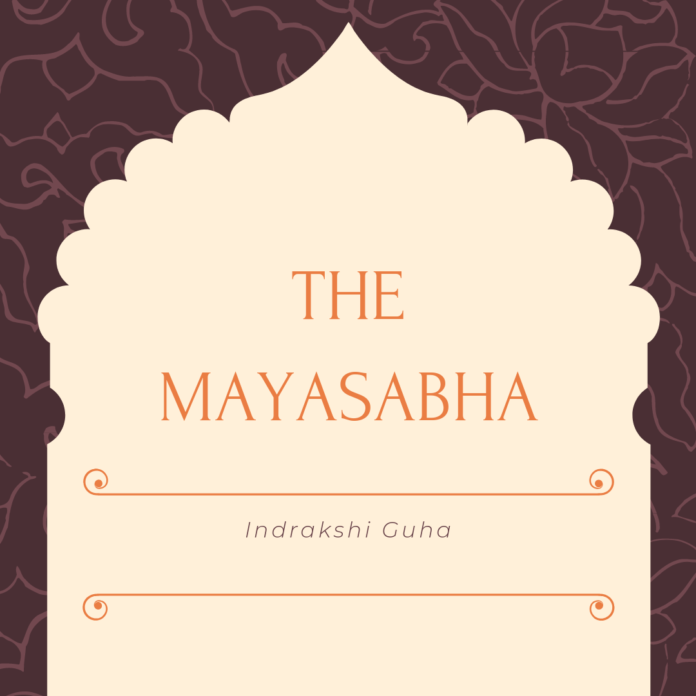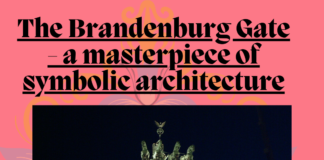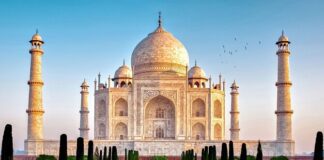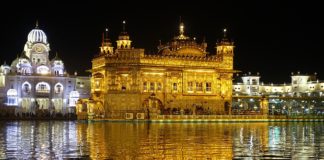The turquoise and green waters of the mahal,
Looked gentle and soothing like my grandmother’s Bangla.
The Gulmohar and magnolias overlooking its balconies,
Looked tender like the pair of ghungroos baba bought for amma.
The conspiracies and mystery in its walls,
Looked like an untold story my grandma hid in our family photograph.
Indian architecture traces back its roots in the rich history and plurality of its cultures. In subdued quietness when the time set itself up for wheels, history rattled its way through eras of tussles and turmoil. History and mythology blends in the smoothest vein to give birth to architecture. One of such monuments which were believed to be an object of envy for the Gods and the asuras were “the Maya mahal “ or “ the Maya Sabha”. This monument was the royal residence of the Pandavas, the five Pandu putras, in Indraprastha. The interesting backdrop which goes behind the scenes into the raising of this palace, the oddly thoughtful magic in its walls, the trickery behind its doors and windows remain engraved in the minds of the lovers of mythology.
Arjuna set fire to the Khandav forest at the orders of Lord Agni. The fire burnt down the forest to ashes, leaving nothing significant at its disposal. In the meanwhile, Krishna solicited the great architect, Maya who made palaces for Gods, and for the asura kings of the underworld to build a palace for the Pandavas as Arjuna saved him from the conflagration Maya was a great king. He possessed brilliance in creativity and marvellous architectural abilities. He was said to have architectural dexterity beyond all standards and benchmarks.
Maya outperformed himself as he built the palace. It was named ” the Maya Sabha”. Maya Sabha surpassed the famous assembly hall of Indra Lord of heaven, in its novelty and exquisiteness. He perhaps laid a parchment of magic to the minutest of things in the palace, turning it into a bouquet of hidden surprises for the Pandavas. Thousands and thousands of golden pillars and jewelleryereereeerought before starting the construction. It took about 14 months to construct the assembly hall. Every room had a smell. Ascent There were waters inside the home. Each room had a pool with scented water. The floors looked like rivers, waterfalls like walls, colourful fountains and glittery doorsteps. Some of the corridors were luminous from the glow of gems. The slabs were made of rubies and gold. The assembly hall was all abounded with flowering trees. The windows were painted on the walls but they were so magical that they viewed the scenery outside the walls on its surface. The pools were often disguised as marble floors. The magic of illusion was spilt all over the architecture. In simple words, Maya Sabha was a dreamland. The beauty and elegance of this Pandava court were put into words in the songs composed at that time. The serenity of the palace embraced its members with love. It was a palace anybody would love to have. It was a familiarity anybody would want to wake up to. It was a cause of envy for anybody who couldn’t possess it. Such an exotic piece of creation it was.
The story of Duryodhana and the elusive pool in the mahal is said to be the initial point that led to the cultivation of hatred and animosity in the Kaurava clan towards the Pandavas. He ended up drenched in a pool that seemed like a bridge. The bridges were made of illusions, light and trickery and caused many a visitor to end up drenching. While he stepped onto the illusory pool, Draupadi and her attendants couldn’t stop smiling. Duryodhana felt comical and embarrassed amidst the women of the court for it was the first time he was lowed down before a woman. However, this story finds its mention in quite a lot of books for it symbolizes how jealousy blinds reality leading one to massive downfall.
The Mayamahal stands as a stunning piece of craft from the architectural point of view. Traditional architecture assigns much importance to the materials used in a building and how they function and work. And this is where traditional architecture differs from modern architecture. There is a lack of ornamental involvement in modern architecture. Modern architecture eliminates decorative mouldings thereby, giving way to simplified designs. Minimalism is the key in modern architecture.
Secondly, an optical illusion is a special feature used in the field of architecture to make buildings look a different way from what they are. For eg: the Taj Mahal’s minarets are placed in a design to create an optical illusion. It keeps on shrinking in size as one approaches it. Maya, the divine architect uses this delicate technique in his creation.
Thirdly, there is a reflecting pool in the assembly hall of the mahal which serves as a tool for purifying the vision of entrants. Architecture is used as a symbol to represent a certain someone, a city or a region. The use of gold, rubies and jewels by Maya and leaving all of it exposed at the sight of the spectators symbolize the open-heartedness and enchanting genuinity of the Pandavas. A brilliant backstory, amazing engineering and a metaphorical idea combine to justify the “may mahal” being referred to as a masterpiece from the fringes of history.
Authored By Indrakshi Guha










